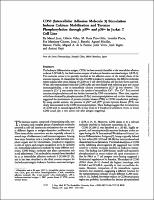Please use this identifier to cite or link to this item:
https://repositorio.usj.es/handle/123456789/1139
| Title: | CD50 (Intercellular Adhesion Molecule 3) Stimulation Induces Calcium Mobilization and Tyrmine Phosphorylation through p59b and p56 in Jurkat T Cell Line |
| Authors: | Juan, Manel

Vinas, Odette Pino Otín, Rosa 

Places, Lourdes Martinez-Caceres, Eva Barcelo, John J. Miralles, Agustín Vilella, Rocchina de la Fuente, Miguel A. Yaguee, Jordi Gaya, Antoni |
| Keywords: | Function-associated; Antigen-1; Receptor cd3 complex; Protein-kinase-c; Signal transduction; Counter-receptor; Costimulatory signal; Cytoplasmic domain; Activation; Alfa-1; Cloning |
| Issue Date: | 1-Jun-1994 |
| Publisher: | ROCKEFELLER UNIV PRESS |
| Citation: | M Juan, O Viñas, M R Pino-Otín, L Places, E Martínez-Cáceres, J J Barceló, A Miralles, R Vilella, M A de la Fuente, J Vives; CD50 (intercellular adhesion molecule 3) stimulation induces calcium mobilization and tyrosine phosphorylation through p59fyn and p56lck in Jurkat T cell line.. J Exp Med 1 June 1994; 179 (6): 1747–1756. doi: https://doi.org/10.1084/jem.179.6.1747 |
| Abstract: | The leukocyte differentiation antigen, CD50, has been recently identified as the intercellular adhesion molecule 3 (ICAM-3), the third counter-receptor of leukocyte function-associated antigen 1 (LFA-1). This molecule seems to be specially involved in the adhesion events of the initial phases of the immune response. To characterize the role of CD50 in leukocyte interactions, the different molecular events induced after cross-linking of CD50 on T cell-derived Jurkat cell line have been analyzed. When cells were incubated with anti-CD50 mAbs and cross-linked with polyclonal goat anti-mouse immunoglobulins, a rise in intracellular calcium concentration ([Ca2+](i)) was observed. This increase in [Ca2+](i) was mainly due to the uptake of extracellular Ca2+. This Ca2+ flux involved tyrosine phosphorylations and was further increased by CD3 costimulation. These data, together with those obtained by phosphotyrosine (P-Tyr) immunoprecipitation and in vitro kinase assays, suggested the involvement of protein-tyrosine kinases (PTK) in CD50 transduction pathways. By using specific antisera, the presence of p56(lck) and p59(fyn) protein tyrosine kinases (PTK) was clearly demonstrated in the CD50 immunoprecipitates. These findings suggest that the interaction of CD50 with its natural ligand (LFA-1) may result in T lymphocyte activation events, in which CD50 could play a very active role after antigen triggering. |
| URI: | https://repositorio.usj.es/handle/123456789/1139 |
| ISSN: | 0022-1007 |
| Appears in Collections: | Artículos de revistas |
Files in This Item:
| File | Description | Size | Format | |
|---|---|---|---|---|
| CD50 (Intercellular Adhesion Molecule 3) Stimulation.pdf | 1,42 MB | Adobe PDF |  View/Open |
Items in DSpace are protected by copyright, with all rights reserved, unless otherwise indicated.
